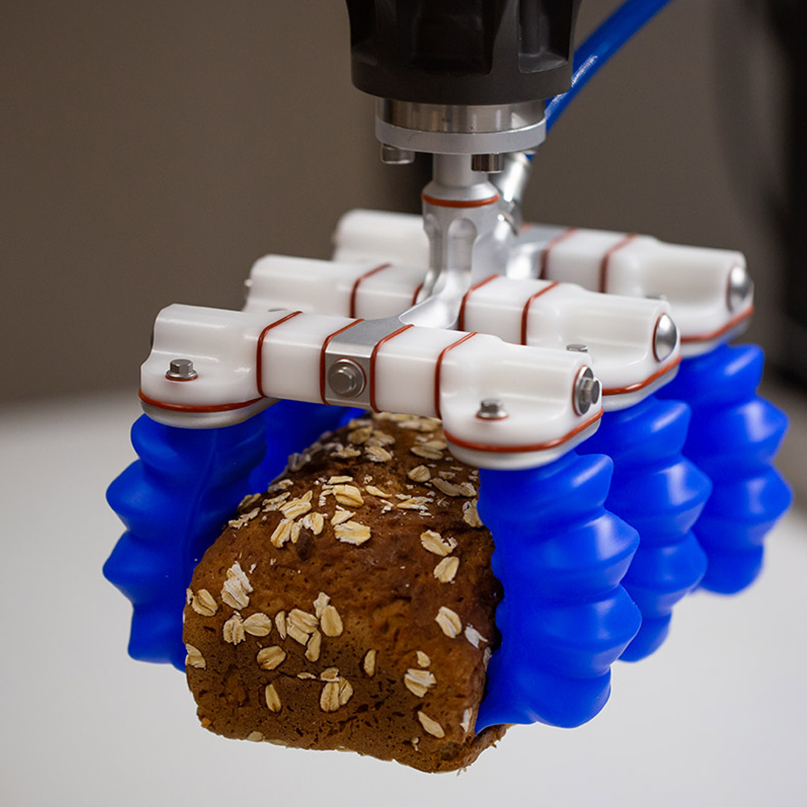⚙️ Core architecture and working principle
1. Contact interface layer
Robotic fingers: high-carbon steel structure, capable of handling geometric payloads (e.g. automotive gears), with a clamping force of up to 500N
Flexible gripper: food-grade silicone material, with a force control accuracy of ±0.1N, suitable for delicate operations (e.g. strawberry picking)
Vacuum end effector: multi-stage suction system, capable of handling 0.5-50kg flat objects (e.g. glass panel installation)
Electromagnetic module: rare earth magnet array, adjustable suction force, up to 50-2000kg (e.g. steel plate handling)
2. Drive system
Pneumatic drive: 0.6-1.0MPa compressed air, response time less than 0.3s (e.g. electronic product sorting line)
Servo drive: motor equipped with harmonic reducer, with an accuracy of ±0.02mm repeatability (semiconductor packaging)
Hydraulic power unit: 35MPa fluid system, supports 10 Payloads over tons (shipbuilding applications)
3. Intelligent control nodes
3D vision guidance: 120fps point cloud processing for random picking
Tactile feedback: strain gauge monitoring, programmable safety thresholds
Edge AI processing: real-time adaptive grasping strategies for new objects
? Application categories
Industrial robot grippers
Automobile welding production line: integrated 6-axis manipulation, door panel positioning within 2 seconds
Semiconductor processing: Class 10 clean room compliant with ESD protection
Collaborative systems
Safety architecture: dual-mode force limitation, collision response time 15ms
Food processing: AI vision-guided flexible fingers, processing 4,000 baked goods per hour
Customized solutions
Medical microgripper: titanium alloy end effector for sub-millimeter container manipulation
Agricultural systems: bionic design with humidity sensing (crop damage rate <0.5%)
? Specific industry applications
Automobile manufacturing
Body-in-white: multi-gripper collaborative control, positioning accuracy of 0.1 mm
Powertrain assembly: Thermal compensation algorithm for 80°C operating deviations
Innovation: Magnetorheological fluid gripper for curved panels
Electronics production
Microcomponent handling: Piezoelectric drive with 0.01N force resolution
Display lamination: Contactless vacuum system for ISO Class 5 cleanliness
Key solution: Shock absorption algorithm for PCB assembly
Perishable logistics
Cold chain operation: Elastomer materials rated at -30°C
Irregular object handling: Deep learning to identify more than 2,000 package contours
Performance: 150,000 operations per day with 0.03% error rate
Heavy industry
Casting applications: Alloy jaw structure rated at 800°C
Large-scale manipulation: Hydraulic synchronization of components with a span of 20 meters
Safety engineering: Triple redundant pressure system with fall protection mechanism
? Quantified operational benefits
Productivity improvement: 40% reduction in automotive production line cycle time
Quality assurance: Assembly force fluctuation ≤2%, yield rate of 99.98%
Return on investment: 300% return in 3 years, maintenance cost is 65% lower than manual labor
Capacity expansion: from micron-level medical device assembly to 100-ton wind turbine blade handling
? Emerging technologies and market development trajectory
Innovation frontier
Smart materials: shape memory alloy self-configuring gripper
Cross-domain integration: tactile feedback and AR remote operation
Autonomous adaptation: reinforcement learning in unstructured environments
Industry indicators
Global market compound annual growth rate of 12.7% (2025-2030)
Collaborative robot penetration rate in automotive electronics 45% 2028
Chinese manufacturers account for 35% of the market share (patent annual growth rate of 40%)


